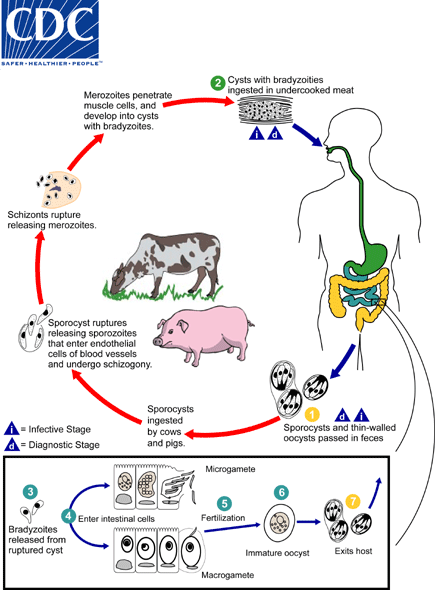Biology
Causal Agent:
Sarcocystis hominis and S. suihominis use humans as definitive hosts and are responsible for intestinal sarcocystosis in the human host. Humans may also become dead-end hosts for non-human Sarcocystis spp. after the accidental ingestion of oocysts.
Life Cycle:

Both sporulated oocysts (containing two sporocysts) and individual sporocysts can be passed in stool  . Sporocysts contain four sporozoites and a refractile residual body. Sporocysts ingested by the intermediate host (cattle for S. hominis and pigs for S. suihominis) rupture, releasing sporozoites. Sporozoites enter endothelial cells of blood vessels and undergo schizogony, resulting in first-generation schizonts. Merozoites derived from the first-generation invade small capillaries and blood vessels, becoming second-generation schizonts. The second generation merozoites invade muscle cells and develop into sarcocysts containing bradyzoites, which are the infective stage for the definitive host
. Sporocysts contain four sporozoites and a refractile residual body. Sporocysts ingested by the intermediate host (cattle for S. hominis and pigs for S. suihominis) rupture, releasing sporozoites. Sporozoites enter endothelial cells of blood vessels and undergo schizogony, resulting in first-generation schizonts. Merozoites derived from the first-generation invade small capillaries and blood vessels, becoming second-generation schizonts. The second generation merozoites invade muscle cells and develop into sarcocysts containing bradyzoites, which are the infective stage for the definitive host  . Humans become infected when they eat undercooked meat containing these sarcocysts. Bradyzoites are released from ruptured cysts in the small intestine
. Humans become infected when they eat undercooked meat containing these sarcocysts. Bradyzoites are released from ruptured cysts in the small intestine  and invade the lamina propria of the intestinal epithelium
and invade the lamina propria of the intestinal epithelium  . There, they differentiate into macro- and microgametocytes. Fusion of male and female gametes
. There, they differentiate into macro- and microgametocytes. Fusion of male and female gametes  results in the formation of oocysts
results in the formation of oocysts  . Oocysts sporulate in the intestinal epithelium and are shed from the host in feces
. Oocysts sporulate in the intestinal epithelium and are shed from the host in feces  . Due to the fragile nature of the oocyst wall, individual sporocysts may also be detected in feces.
. Due to the fragile nature of the oocyst wall, individual sporocysts may also be detected in feces.
Life cycle image and information courtesy of DPDx.
- Page last reviewed: August 29, 2012
- Page last updated: August 29, 2012
- Content source:


 ShareCompartir
ShareCompartir